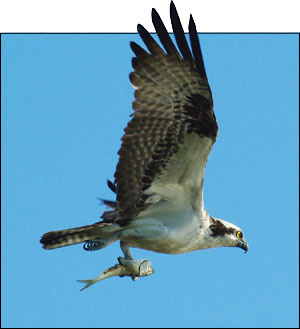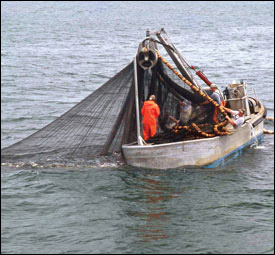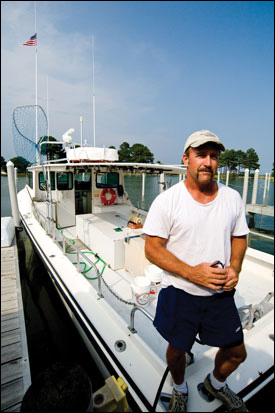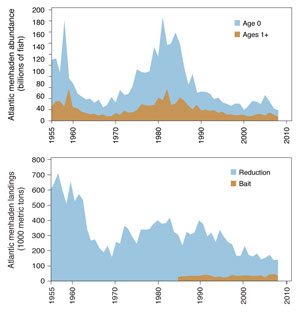|
Food Fish Fight
Ecosystem-Based Fisheries Management and the Menhaden Wars
Michael W. Fincham

An osprey who spotted a school of menhaden heads back to the nest. Fred Rogers captain of a "snapper rig" called the FV Hush Puppy, surveys a school of menhaden caught in his net. Photograph of osprey by John Gresham; photograph of Fred Rogers by Harold Anderson for the Smithsonian Center for Folklife & Cultural Heritage.
IT WAS A DAY LIKE THIS WHEN THE OSPREY GOT ROBBED.
Today the menhaden were running and the FV Hush Puppy was running after them. The guy up in the spotter plane was reporting fish, and Fred Rogers, down on the fishing boat, started working his binoculars, looking for osprey.
Like spotter pilots, ospreys are skilled at spying fish in the water — so skilled they're called fish hawks. An adult osprey, with its pale body and dark, hawklike wing spread, is a master fish killer: It can slap the water like a skipping stone as it swipes a small fish off the surface or splash down and sink its talons into a bigger fish gliding lower in the water.
Menhaden are not big fish, but they travel in large schools, making them easy to spot from the air. To a pilot, a crowd of menhaden, tightly bunched, can look like a clump of dark green broccoli bobbing just below the surface. Or a school, numbering tens of thousands, can stretch out and bend and curve like a strand of wet spinach waving in the water. To birds wheeling above, to rockfish and weakfish and bluefish swimming up from below, these masses of menhaden look like a moveable feast.
To Fred Rogers on board the Hush Puppy, they are a losable feast. Rogers could lose his menhaden to birds and to fish but most often to other fishermen. His Hush Puppy, 80 feet long with a steel bottom, is competing with four other boats, all known locally as "snapper rigs," that also hunt menhaden in the mid-Bay region of the Chesapeake. His big competition, however, comes from a nearby fleet of ten larger, industrial fishing boats, most of them twice the size of the Hush Puppy, all of them carrying two net boats. This fleet of big boats comes out of Reedville, a fishing village down at the end of the Northern Neck of Virginia, where Omega Protein, a Houston-based company, runs the last large-scale menhaden processing plant left along the Atlantic Coast.
As soon as he sighted osprey off to the north, Fred Rogers ordered four of his crew off the Hush Puppy and down into the small net boat they were towing. Then he jumped in and quickly gave chase.
Why are so many boats competing for menhaden — a small, oily fish that most people have never heard of? You won't, after all, see menhaden in supermarkets or seafood stores or on restaurant menus. If the fish are caught by snapper rigs or pound netters, they usually end up as bait for crabbers and chum for charter boat crews trying to catch striped bass. If they are caught by Omega's fleet, on the other hand, menhaden will be compressed or "reduced" into fertilizer, fish meal, or fish oil. If you eat farm-raised fish or chicken, you may be sneaking menhaden into your diet. If you pop a daily fish oil pill with omega-3 fatty acids, you may be using menhaden to keep your heart healthy. If you give your house a new coat of paint, menhaden oils could be part of the paint mix. Products for agriculture, aquaculture, industry, and health foods — and bait for fishermen. It's no wonder the little menhaden is a big money fish.
With fish stocks at a 54-year low, it should be no surprise that all this commercial harvesting of a depressed fish stock is stirring a growing controversy. Many scientists are calling for a new way of managing fisheries and dozens of sportfishing and environmental groups are calling for cutbacks in a way of fishing that has thrived in the Chesapeake for more than a century.
Gliding up to his school of menhaden, Fred Rogers and his crew dropped a sea anchor, an underwater parachute that holds one end of a purse seine net. Motoring in an arc, the crew began spooling out net behind them, carving a circle around the fish. Several osprey and pelicans soon came wheeling lower to feed, and some of the target fish began slipping out of the closing corral. Snapper rigs like this work more slowly than the big Omega ships that can each launch two net boats at the same time. Two boats, each carrying one end of the net, can encircle a school of fish twice as fast.

Rogers and his crew (top) haul in a net full of menhaden. With purse seine nets they circle around and underneath a school of menhaden. After running the two ends of the net through a power block, they are able to close up the "purse," preventing any escape below the net. The purse boat then drags the full net to its mother ship, the FV Hush Puppy (bottom, heading out of Reedville, Virginia for a day of fishing), where menhaden are vacuumed up into a refrigerated hold. Photographs by Harold Anderson for the Smithsonian Center for Folklife & Cultural Heritage.
Closing the loop back to the anchor end of the net, Rogers hooked the two net ends together. With the purse seine now surrounding their target fish, the crew began drawing the net together from underneath the school, cutting off any deep escape routes. Running the two net ends through a mechanized pulley, called a power block, Rogers and his men began to zip the purse, winching up the net and forcing the fish catch toward the surface. The water in the loop began to fleck and bubble, the surface dimpling as though raindrops were splattering it from below. More birds descended.
Back on the high bridge of the Hush Puppy where he worked the wheel, veteran deckhand Phil Shahan pointed out a familiar sight: Many of the menhaden down in the net were banding together for a jail break. "They always break toward the sun," said Shahan as the massed fish surged toward one end of the corral. A line of foam began to form along the net line as masses of fish butted up against the tightening mesh.
Up on the bridge with Shahan was Fred's father, Ray Rogers, a retired net maker who still enjoyed watching his son work a net set. He could see ospreys dipping lower to pluck at the trapped fish and several pelicans simply plopping down in the middle of the loop like they were settling in for dinner.
When Shahan talked of seeing a pelican chase down an osprey for its fish, Ray Rogers, then in his 70s, talked about the day he watched the osprey get robbed. He saw a fast-moving eagle swooping after a fish-carrying osprey. The eagle made multiple runs, swiping and swiping at the osprey and its prey. "He just kept fooling with him and fooling with him," said Rogers, until the exasperated osprey finally dropped the fish and darted away. Whirling on an unseen dime, the eagle dove toward the water, said Rogers, then swung under the falling fish and, like an acrobat, flipped on its back and caught the fish in its claws — all before it could hit the water.
Eagles and osprey aren't the only ones willing to go to war over menhaden these days. Clearly angered by the spectacle of industrial-scale fishing, sportfishermen have organized to push hard for restrictions on the commercial menhaden harvest, a tradition that dates back 140 years in Virginia waters.
In their view every net that lifts menhaden out of the Bay robs food from the mouths of fish and birds. It's not exactly an altruistic argument: Sportfishermen, of course, want more menhaden as food for rockfish, weakfish, and bluefish, the fish they like to catch. Groups such as the Coastal Conservation Association and the Maryland Saltwater Sportfishing Association have created the Menhaden Coalition, an alliance that includes 33 sportfishing and environmental organizations with total memberships topping 400,000 and a common goal of saving menhaden as a food fish. In the last two decades their combined communication campaigns have focused the policy debate on one key question: Who gets first call on the menhaden bounty of the Chesapeake Bay?
Should it be the ten big boats of Omega Protein? The five smaller snapper rigs? The pound netters who work along Maryland and Virginia shorelines? What about the striped bass and bluefish? What about the eagles and ospreys?
Who gets the biggest share in this food fight? And who gets robbed?
Most of the commercial harvest of Atlantic menhaden occurs in Virginia waters, either along the ocean side or in the southern half of the Chesapeake. In 2010, Omega Protein, based in Reedville, Virginia, operated a fleet of ten commercial fishing vessels that set purse seine nets from New Jersey to North Carolina. Only Virginia and North Carolina, however, allow netting inside the three-mile, state-managed zone. Since 1995, the snapper rig fleet has varied between three and five vessels. In 2005, four vessels made the vast majority of their net sets south of the Potomac and north of the Rappahannock. The snapper rigs and the Omega boats together turned this mid-Bay area into the menhaden breadbasket of the Chesapeake. Source: Joseph Smith, National Marine Fisheries Service.
Questions like these usually get answered by the Atlantic States Marine Fisheries Commission, the multi-state body charged with regulating coastal fisheries. In its August meeting, the commission voted to consider new restrictions on commercial harvesting. The problem was clear: Coastal menhaden stocks dropped from an estimated 160 billion fish in 1985 to 40 billion in 2008. And the solution was hopeful: Harvest cutbacks might let more menhaden reach spawning stage.
Before making a final decision on harvest cutbacks, however, the commission will hear three months of public comments. When the commission meets for a final vote in November, its options will be: Move forward with the harvest cutbacks. Or cancel them. Or ask for more study.
The debate over who gets how many menhaden is clearly heating up again, but this time with a new twist. According to environmental advocates, cutting back on commercial harvesting could be a historic step toward adopting a new paradigm about the best way to manage this country's fisheries.
The new approach goes by the name "ecosystem-based fisheries management." A philosophy as much as a method, it has yet to be applied in fishery cases, especially cases like the menhaden management wars. By placing primary focus on the health and structure of the ecosystem, this approach reverses traditional priorities featured under "single-species management." That system focused first on a target species and then went to work figuring out how to achieve a "maximum sustainable yield" within current ecosystem conditions. Under the new paradigm, however, fishery managers would look first at the "ecosystem services" that menhaden might provide and then balance those benefits against any economic payoff from the commercial harvest.
Menhaden, for example, play a crucial role in the energy flows of the ecosystem. As heavy plankton eaters, they convert plankton energy to fish flesh (their own) which then becomes forage food for fish-eating species at the top of the food chain. "Menhaden have a unique role in that mid-trophic position," says Dave Secor, a fishery biologist with the Chesapeake Bay Laboratory. "There are not many fish that perform that role in the Chesapeake."
This food issue, the forage fish concept, has also become the central argument for sportfishing advocates and environmentalists who want to build their case for harvest cutbacks — and they're expecting that scientists will back up their claim.
The new approach, however, has its advocates, its doubters, and its disbelievers, and its new influence on policy has put scientists back in the middle of the menhaden wars. (They've been there before.) Doubters would seem to include the snapper rig operations and Omega Protein, the large corporation that sells fish oil products around the world. Their spokesmen say the current fishery is sustainable under traditional management approaches.
At the heart of the conflict is a core concept out of ecosystem theory: Menhaden might prove more valuable swimming in the water than floundering in a commercial net. If menhaden are important to the fish and fowl that feed on this species, is that reason enough to force cutbacks on a historic fishery? It's become the central question in the debate over the commercial harvesting of menhaden.
This time the rockfish, eagles, and osprey might get a bigger share of the menhaden bounty, and the commercial fishermen might feel they're the ones getting robbed.

As a charter boat captain and owner of the Ingram Bay Marina, Billy Pipkin has survived recessions in the economy and slumps in the stocks of popular fish like striped bass and bluefish. He's now worried about whether the rebound of striped bass, his bread-and-butter fish, will survive a localized depletion of menhaden, a striper's bread-and-butter-food. "If the menhaden industry has to cut back, hopefully they will be willing to do it," he says. Living just south of Reedville, he's seen firsthand the importance of the industry to the local economy. "At the same time, you've got to see past your hand," he says. "There's a great future ahead as long as the science is right and the management is right." Photograph by Michael W. Fincham.
The outcome of this new menhaden policy, if it passes final muster, could prove a decisive test case for the value of this new paradigm in fisheries management. Would ecosystem-based fisheries management do a better job with this species than single-species management?
The low level of menhaden stocks worries sportfisherman because it threatens the hard-earned recovery of striped bass stocks that began under a single-species approach back in the early 1980s. It was a recovery that came with some pain: A moratorium on fishing was followed by a carefully monitored quota system imposed on both commercial and recreational fishermen. But the pain paid off: Striped bass populations increased from less than 9 million in 1982 to more than 70 million by 2004.
Menhaden were important in the recovery because the species is the favorite prey for striped bass. Young stripers switch into their fish-eating stage by feeding first on small prey like bay anchovies and then graduating to juvenile menhaden, according to Jim Uphoff, a researcher with the Maryland Department of Natural Resources. Striped bass chase menhaden for the same reason Omega's boats chase them. Their high lipid content creates an energy source for stripers as well as an oil source for Omega. As they grow older and larger, stripers keep eating menhaden, moving up to larger, older menhaden. "These older striped bass are capable of eating all sizes of menhaden," says Uphoff. "And they do."
The recovery of striped bass stocks seemed to stand as the best evidence that smart management — in this case single-species management — can save a fishery. "None of us are big fans of government regulation," says Billy Pipkin, a charter boat captain located south of Reedville who well remembers the pain of the moratorium. "But if it wasn't for government intervention in the striped bass industry, we would be without striped bass now," he says. "I'm thankful the fishery is back. That's a large part of my income."
The recovery strategy, it now appears, may have been flawed. In a number of studies, the recovery of striped bass is now being implicated in the decline of menhaden. Rebuilding striped bass populations was the same as dropping another fleet of harvesters into the Bay, says Uphoff, a field researcher who models the bioenergetic needs of fish populations. Since 1997, according to his calculations, that fleet of stripers may have been harvesting more menhaden than the fleet of Omega boats.
"The striped bass recovery was a great success story that was also a failure," says Bill Goldsborough, senior fishery scientist with the Chesapeake Bay Foundation and a member of the Atlantic States Marine Fisheries Commission. "If you are going to maintain a high level of a predator, you have to preserve its primary food base," says Goldsborough. Single-species management succeeded in bringing back stripers, as he suggests, but it failed to figure out how all those new stripers would change the ecosystem.
Under an ecosystem approach, however, some things previously hidden could now become clearer. When striped bass populations dropped off after 2006, for example, and more fish began showing signs of malnutrition and disease, fisheries managers began considering a cutback on commercial and recreational fishing. The short term goal: Increase the spawning stock. The long-term goal: Increase the number of striped bass along the East Coast of the United States. If the strategy works, however, the result could be a bigger fleet of stripers chasing menhaden. This time, at least, fishery managers would see the surge coming.

Populations of menhaden have risen and fallen dramatically over the past 55 years and — to a lesser degree — so have commercial harvests. Menhaden fish stocks (top graph) hit their high points in the mid 1950s and again in the late 1970s and early 1980s. Commercial harvests (lower graph) also peaked in the 1950s — but never reached that level again. When fish stocks slumped during the 1960s and again during the 1980s, many factories north of the Chesapeake closed, never to reopen again. Since the 1950s, the fishing fleet has dwindled from 150 vessels to 9 this year, and the number of factories has gone from 25 to 1, Omega Protein of Reedville, Virginia. Source: ASMFC Stock Assessment Overview — Menhaden, May 2010, Atlantic States Marine Fisheries Commission.
And this time they could try to get ready. A cutback on the commercial menhaden harvest might — with luck and a large year for new menhaden — rebuild populations of the oily food fish that stripers like to chase. Or it might not. At the very least, the cutback on striper harvest would require some sacrifice from recreational fishermen who share a passion for stripers, letting them share some of the pain now proposed for menhaden fishermen.
Will fisheries managers also get ready for the return of ospreys? After the outlawing of the pesticide DDT in the 1970s, these master fish killers increased their numbers tenfold in the Chesapeake region. And so did eagles and brown pelicans and great blue herons and other birds — all of which love to feast on menhaden. According to a recent review of the research literature, however, most ecosystem models have largely ignored the looming impact of all these flying fish eaters on menhaden populations.
Are they eating many menhaden? Only one published report examines the diets of osprey in the Chesapeake region, and it dates back to research done in 1985. Two scientists from the College of William and Mary spent two months observing osprey nests and estimated that menhaden made up 75 percent of an osprey's diet. They saw their osprey bring home to the nest an average of 5.4 fish per day, a haul that included white perch, croaker, toadfish, and American eel, but was mostly made up of menhaden. And on two vivid days they saw something else: An osprey flying home not with one, but with two menhaden, one clutched in each set of talons.
Will a new paradigm that surveys an entire ecosystem of competing species ever prove as successful as a single-species approach once did? The evidence is not in, but expectations are still high. For managing a collection of fisheries that interconnect in unexpected ways, ecosystem-based fisheries management begins with this great advantage. "It is a more cautious way of doing business. You are attempting to make these linkages," says Uphoff, "rather than managing as though they don't exist."
|